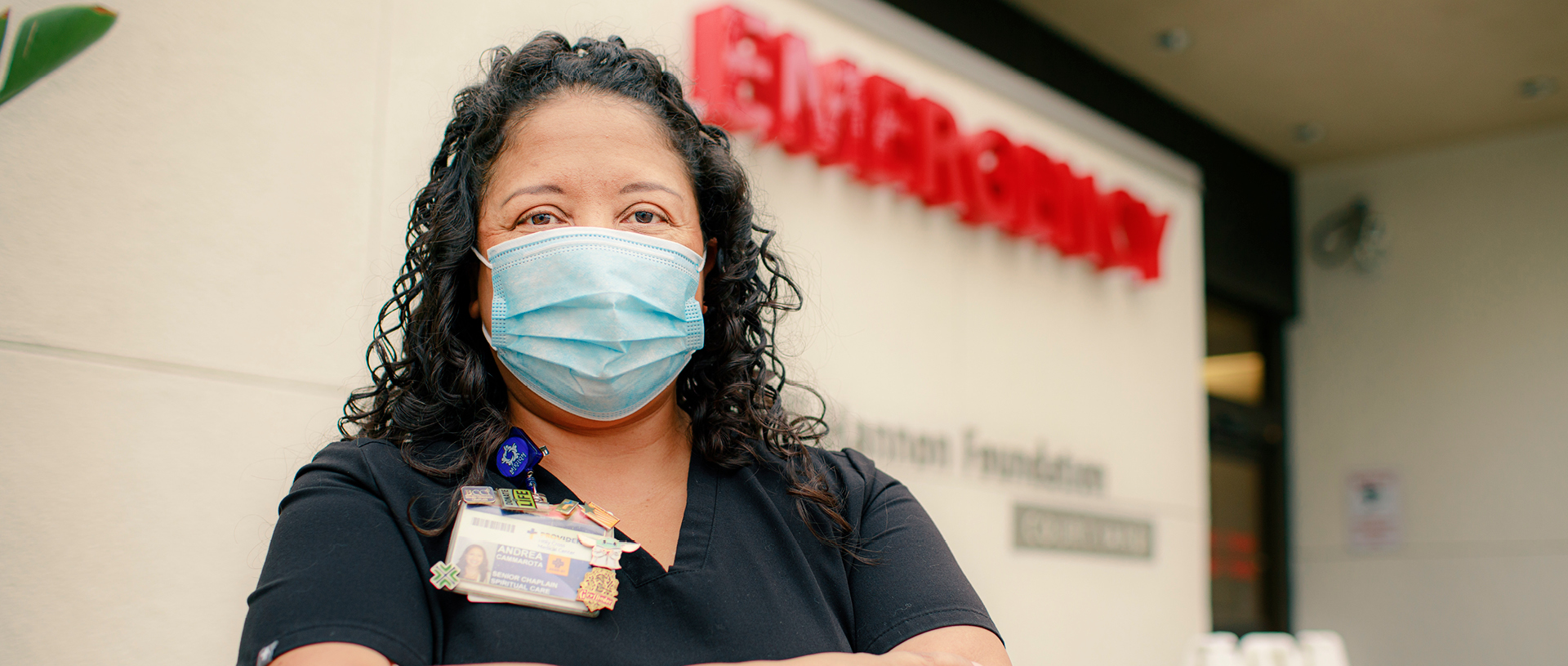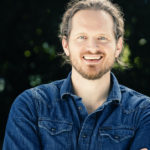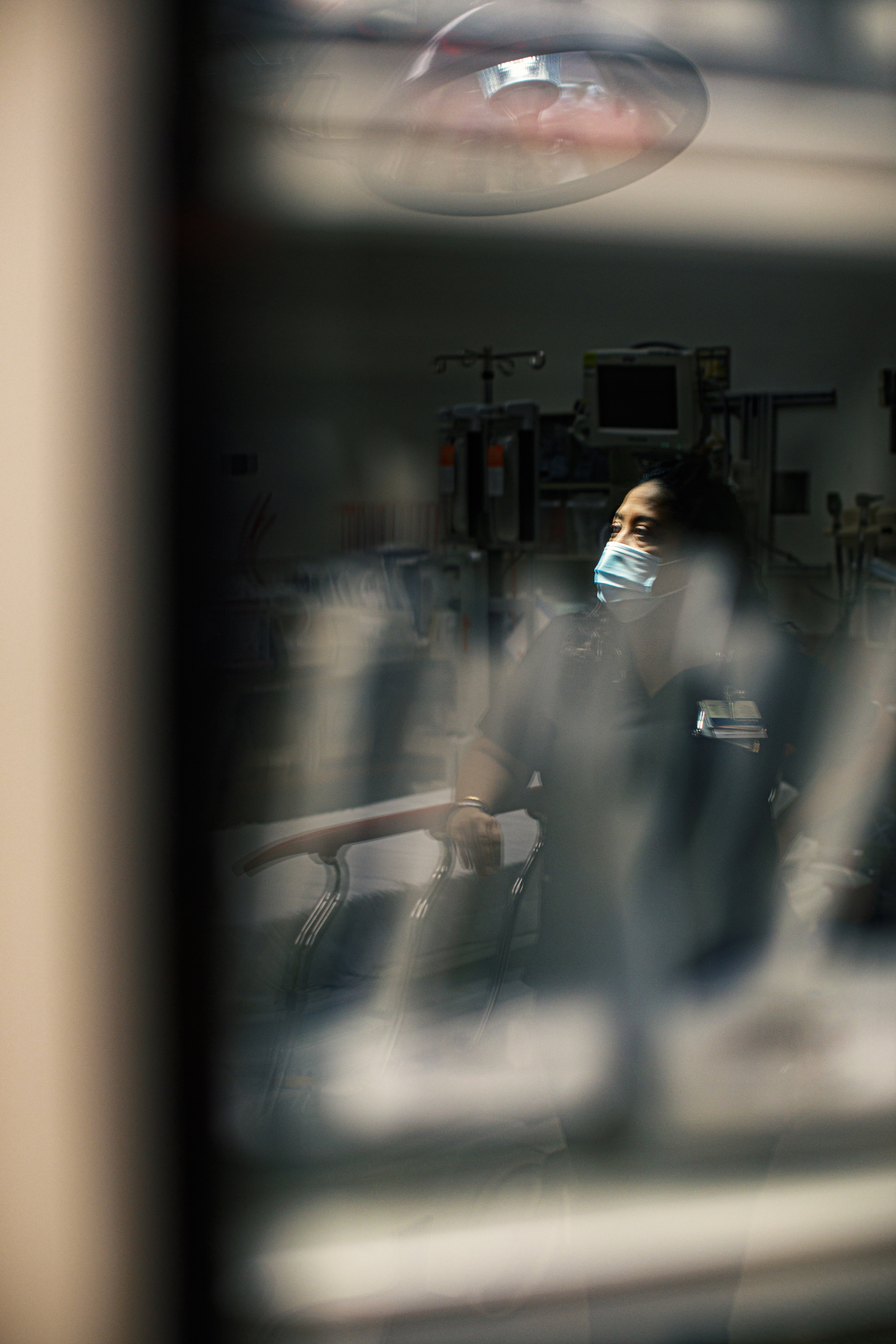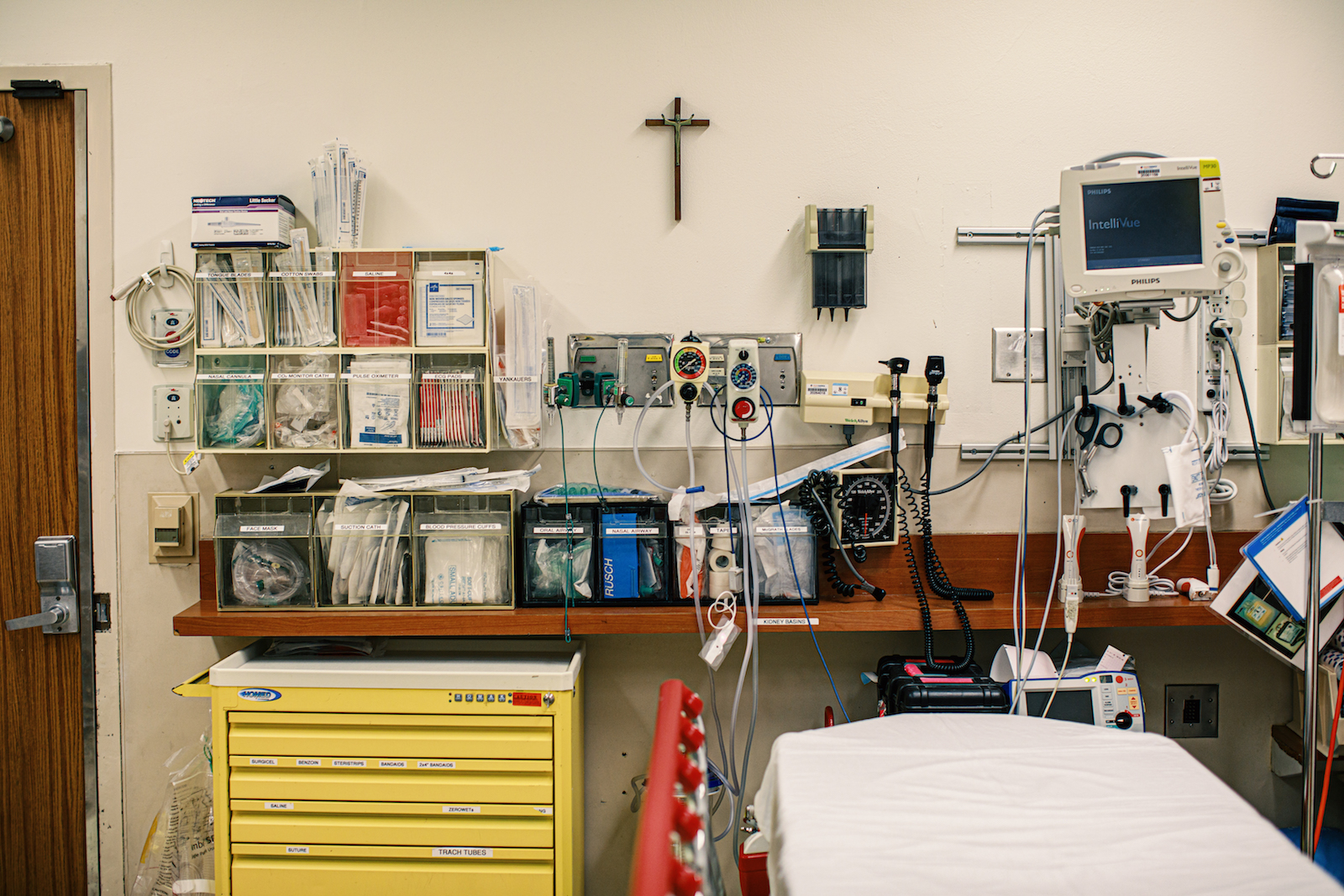
Chaplaincy isn’t just something you pick out of a catalog, like, ‘Oh, maybe this one,’” says Andrea Cammarota (MAT ’02). “You really have to be called to it.” After a 14-year career in the Los Angeles Unified School District, Andrea felt that call to chaplaincy. She had been dissatisfied with her career for years, and spent time praying about it. She jokes that it was as if God said, “Remember that Fuller degree you have? How about if we actually put that into place?” Her training from Fuller wasn’t the only factor in her jump from education to chaplaincy. Andrea had also nurtured a longtime interest in healthcare, a result of her own origin story: abandoned at the hospital as a baby, she spent the first three months of her life cared for by a team of doctors and nurses before her parents adopted her. “Chaplaincy seemed like a way of giving back that felt organic,” she says. She liked the idea of serving in a hospital, a place where people are often most in need.
Andrea started the Clinical Pastoral Education program at Long Beach Memorial Hospital in Long Beach, California, in the fall of 2010. The actual work of the training program, she says, was sink or swim. At Long Beach Memorial, a Level II Trauma Center, people can be admitted with gunshot wounds, stabbings, injuries from domestic violence—and everything in between. “It offered a lot of really good, in-your-face experience,” says Andrea.
During the program, she realized she thrived when responding to trauma and wanted to work at a trauma center once she was done with her training. “There is a part of me that’s an adrenaline junkie: the speed and the pace and the unpredictability of an emergency room is what I love to do.” Now Andrea is in her eighth year as a hospital chaplain, working at Providence Holy Cross Medical Center in Mission Hills, California, where she mainly serves in the emergency department.

Joy Netanya Thompson (MAT ’12) is communications senior editor at Fuller. She is a writer focusing on the intersections of theology, motherhood, and pop culture, and has published her work in Sojourners, RELEVANT, Motherwell, and Outreach magazine, among others. Find her at joynetanyathompson.com.

Nate Harrison is Director of Photography and Senior photographer. His personal work can be found at NateCHarrison.com
Chaplaincy isn’t just something you pick out of a catalog, like, ‘Oh, maybe this one,’” says Andrea Cammarota (MAT ’02). “You really have to be called to it.” After a 14-year career in the Los Angeles Unified School District, Andrea felt that call to chaplaincy. She had been dissatisfied with her career for years, and spent time praying about it. She jokes that it was as if God said, “Remember that Fuller degree you have? How about if we actually put that into place?” Her training from Fuller wasn’t the only factor in her jump from education to chaplaincy. Andrea had also nurtured a longtime interest in healthcare, a result of her own origin story: abandoned at the hospital as a baby, she spent the first three months of her life cared for by a team of doctors and nurses before her parents adopted her. “Chaplaincy seemed like a way of giving back that felt organic,” she says. She liked the idea of serving in a hospital, a place where people are often most in need.
Andrea started the Clinical Pastoral Education program at Long Beach Memorial Hospital in Long Beach, California, in the fall of 2010. The actual work of the training program, she says, was sink or swim. At Long Beach Memorial, a Level II Trauma Center, people can be admitted with gunshot wounds, stabbings, injuries from domestic violence—and everything in between. “It offered a lot of really good, in-your-face experience,” says Andrea.
During the program, she realized she thrived when responding to trauma and wanted to work at a trauma center once she was done with her training. “There is a part of me that’s an adrenaline junkie: the speed and the pace and the unpredictability of an emergency room is what I love to do.” Now Andrea is in her eighth year as a hospital chaplain, working at Providence Holy Cross Medical Center in Mission Hills, California, where she mainly serves in the emergency department.
Joy Netanya Thompson (MAT ’12) is communications senior editor at Fuller. She is a writer focusing on the intersections of theology, motherhood, and pop culture, and has published her work in Sojourners, RELEVANT, Motherwell, and Outreach magazine, among others. Find her at joynetanyathompson.com.
Nate Harrison is Director of Photography and Senior photographer. His personal work can be found at NateCHarrison.com


Every day as a chaplain is different, which she loves. On a quieter day, Andrea checks in with the clinical team, the physicians and nurses, who are part of her ministry as well. On those days, she does “a lot of intentional loitering” to create opportunities for conversations with the staff where they might open up about stresses or relationship problems. “So many people are unchurched now,” says Andrea, and they lack the spiritual support everyone needs. Building relationships with the clinical staff has an added bonus: the doctors and nurses see for themselves the benefits of chaplaincy, and are more likely to refer patients in crisis to the spiritual care team.
Most days, however, aren’t quiet. “Crazy days can be anything,” says Andrea. Where she works in the emergency room, traumas coming in range from a ground-level fall to a shooting to a suicide attempt. “There are just so many awful things that happen in this world that come through our doors,” she says. “I really have to be ready for anything.” As a chaplain, part of her job is helping get families to the patient’s bedside or calling loved ones to inform them of the patient’s admission. Mostly, though, it’s “filling that sacred space at bedside, however it needs to be filled.” Sometimes that means sitting quietly with a person who has been in a car accident and is shaken or disoriented. Other times, says Andrea, “it’s picking someone up off the floor who just found out their loved one has died.”
The coronavirus pandemic has complicated all of Andrea’s work. Holy Cross stopped allowing visitors in March 2020 and was still closed to visitors at the time of this writing, six months later. Without family at the patient’s bedside, even the most difficult, personal matters must be discussed over the phone, or on the sidewalk outside the emergency room. “It’s been terrible,” says Andrea. “Limiting how many people are allowed in at the time of death in an end-of-life situation has been especially heartbreaking.”
She tries to offer support to the patients’ families without sugarcoating the situation, acknowledging how hard it is to have someone in the hospital during COVID. Andrea often tells them, “We’re going to do our best to make it the least awful we can, and it’s still probably going to be really bad.”


Still, she sees her job as “figuring out what’s been buried in this crisis for the person—going through the rubble and helping them find whatever resources have been hidden underneath it all.” To do that, she needs to actively listen to the person while also paying attention to what God might be pointing to. “It requires a lot of presence and the ability to not get too distracted by the trauma itself,” she says.
Andrea remembers a time when she sat with an elderly man whose brother was dying. “The patient had been sick for a long time, but his brother was resisting putting him on comfort care,” she recalls. They talked for almost an hour, and the man, who was a retired pediatrician, shared about his career and how much he loved helping bring babies into the world. He used to tell the expectant mothers, “Everything you need to know, you already know . . . you’ve got this.” After Andrea and the man had talked for a while, they sat quietly and watched the man’s brother struggle to breathe. The man said, “I know that it’s time but I’m just not ready.” Andrea felt like God was telling her to quote the man back to himself, so she said, “I’m just going to give your advice back to you: everything you need to know about what needs to happen next, you already know.” He began to weep. “That’s one of those conversations that I feel really privileged to have had,” she says.
Some days as a chaplain, an encounter like that is the biggest thing that happens, and everything else is “your garden variety bedside visits, a prayer here and a prayer there,” says Andrea. But other days she’s slammed with one trauma after another. “You triage which ones are the most critical, you put on the back burner the things that can wait, and you figure it all out somehow,” she says. “And I love those days just as much.”
Andrea admits that her experience as a hospital chaplain is different from other variations of the role. “I see a lot of things in the ER at Holy Cross that a chaplain at a sleepy community hospital will never see,” she says. While she thrives on the fast pace of a trauma center, she admits that she’s not cut out to serve in other chaplaincy roles, such as ministering in the oncology unit. “I don’t want to know you at the beginning of your treatment and watch you slowly die,” she says. “But I have colleagues who are made for that.”
At Holy Cross, residents in training are sometimes surprised by how little “churchy stuff” they end up doing, says Andrea. On the surface, the chaplains’ work might seem very logistical, their role almost like a liaison between the doctors, the patients, and the families. But underneath it all runs “a current that is divine,” she says. “It’s God using you to ease these people’s way, to make the journey a little softer, and to be that person who is there with them on what may very well be the worst day of their lives. And that’s always sacred, even if you never say ‘God,’ or you never say ‘Amen.’”
“If you don’t ever bring up Jesus, you’re still Jesus in the room,” says Andrea. In fact, she notes that the subtle, pastoral presence the chaplains offer is modeled after many of Jesus’ encounters with people in the Gospels, where he quietly acknowledged the dignity of their humanity. As a chaplain, Andrea sees part of her ministry as acknowledging another image bearer for who they are. “Whether you’re coming in spaced out on meth and don’t know your own name, or you’re 90 years old quietly grieving your husband’s passing, whatever it is: we are going to acknowledge that we see God in you, and we see God in this.”

As he works to advocate for the autistic community, Cameron Keirnes learns to confront cultural assumptions and move toward mutual vulnerability